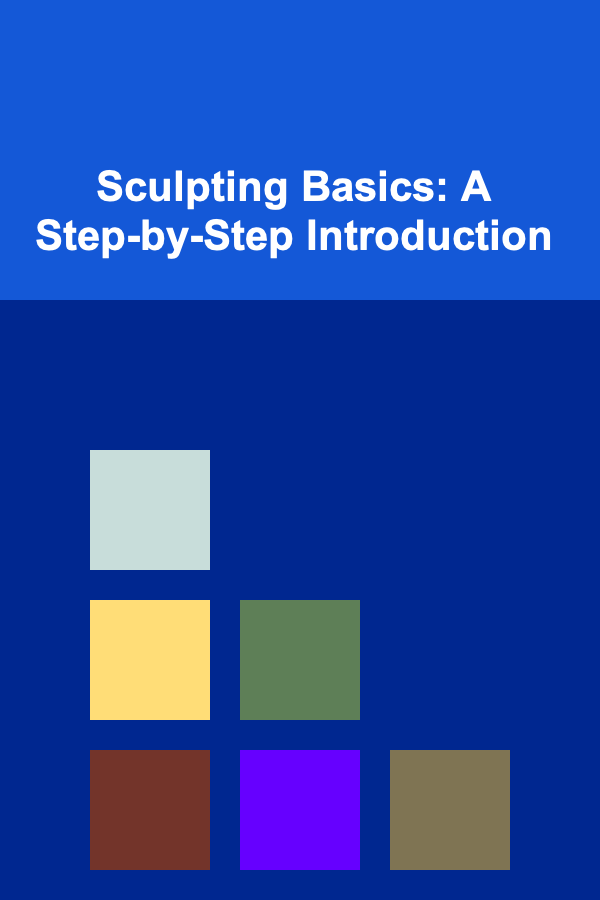
Sculpting Basics: A Step-by-Step Introduction
ebook include PDF & Audio bundle (Micro Guide)
$12.99$7.99
Limited Time Offer! Order within the next:

Sculpting is an art form that has been around for centuries, evolving through various styles, materials, and techniques. From the classical statues of Ancient Greece and Rome to the modern abstract works seen in galleries today, sculpture has always been a profound means of expression. Whether you're a beginner eager to try your hand at sculpting or an experienced artist looking to refine your skills, this guide will introduce you to the fundamentals of sculpting.
In this article, we will explore the various stages of sculpting, the materials commonly used, and essential techniques to help you start creating your own sculptures. With step-by-step instructions and helpful tips, you'll be well on your way to making your first sculpture.
Getting Started: What You Need to Know
Before diving into the actual process of sculpting, it's important to understand the key components that will make up your sculpting journey. Sculpture is a three-dimensional art form, which means that it involves creating an object that can be viewed from multiple angles. The goal is to give the viewer a sense of depth, volume, and texture that can only be appreciated through tactile and visual engagement.
1. Choosing Your Material
The first step in sculpting is deciding what material you want to work with. Sculptors can use a variety of materials, each with unique properties and challenges. Some of the most common sculpting materials are:
- Clay: This is one of the most popular and versatile materials for beginners. It is easy to shape and mold, and there are different types of clay to choose from. Air-dry clay is ideal for beginners, while oil-based clays are favored for more advanced sculptures due to their ability to hold fine details.
- Wax: Often used in the process of casting, wax is malleable and can be easily shaped. It is a common material for creating small, intricate sculptures or for preparing models for bronze casting.
- Wood: Wood sculpting is an ancient technique that requires both patience and precision. It is typically done with carving tools, and the grain of the wood can add a unique texture to the final piece.
- Stone: Stone is a more advanced material that requires specialized tools like chisels and hammers. Sculpting stone can be challenging, but it is ideal for creating large, durable works of art.
- Metal: Metal sculptures are often created through casting or welding techniques. It is a material that provides excellent durability and allows for large-scale pieces. Artists can use metals like bronze, aluminum, or steel to create various shapes and forms.
2. Gathering Tools
The tools you choose to use for sculpting will depend on your material and the technique you plan to use. Here's a basic list of tools for clay, wood, and stone sculpting:
-
For Clay:
- Modeling tools: These include wire end tools, spatulas, and smoothers. They help shape, carve, and detail the clay.
- Rolling pins: These are useful for flattening and smoothing clay.
- Cutting tools: A sharp knife or blade helps to cut through clay.
-
For Wood:
- Chisels: These tools come in various shapes and sizes, allowing you to make precise cuts and create detailed work.
- Gouges: Used to scoop out larger chunks of wood for rough shaping.
- Rasps and files: These are used for smoothing and refining the surface of the wood.
-
For Stone:
- Hammers and chisels: These are essential for breaking down stone and refining shapes.
- Pointing tool: This tool is used to measure proportions and transfer designs onto a stone block.
- Files: To smooth the surface of the stone once the basic shape has been sculpted.
3. Setting Up Your Workspace
A clean, organized workspace is essential for sculpting. Make sure your workspace is well-lit and has ample room for you to move around. A sturdy table or workbench is ideal for creating sculptures. Additionally, keep all your tools within reach and set up any protective gear (like gloves or goggles) to ensure safety when working with materials like stone or metal.
Step-by-Step Introduction to Sculpting
With the necessary materials and tools ready, let's dive into the sculpting process. Whether you're working with clay, wood, or stone, the following steps are universally applicable and will guide you through the process of creating your own sculpture.
Step 1: Conceptualize Your Design
Before you begin sculpting, take some time to plan your piece. Ask yourself what kind of sculpture you want to create and whether you want it to be representational or abstract. Many artists start by making sketches of their ideas or creating small-scale models (called maquettes) to test proportions and design.
- Create a sketch: A basic drawing will help you visualize the sculpture's form, size, and details. For larger pieces, sketches from multiple angles are often necessary.
- Consider proportion: Think about how the various parts of your sculpture will relate to each other in terms of size and spacing. This is especially important in representational works, like human or animal figures.
Step 2: Create a Basic Armature (if Necessary)
For larger sculptures, you may need to create a base structure, known as an armature. The armature serves as a skeleton or framework for your sculpture and helps support it as you add material.
- For clay: You can use a wire frame or foil to create the basic shape of your sculpture. This prevents the sculpture from becoming too heavy and ensures that it holds its form as you build up layers of clay.
- For larger sculptures: For wood or stone, the armature might consist of a simple framework made from wood or metal rods, providing a structure to work around.
Step 3: Block Out the Basic Shape
Once the armature (if necessary) is in place, begin adding your chosen material to create the basic shape of your sculpture. This is called blocking out, and it involves creating the rough outline of your piece.
- For clay: Begin by rolling out large chunks of clay and attaching them to your armature. Use your hands to shape and build up volume in the areas you want to sculpt.
- For wood: Start removing larger sections of material with your carving tools to create the basic form. Keep your cuts rough at this stage, focusing on creating the primary shapes.
- For stone: Start chiseling away the rough material using large tools. You'll need to remove larger portions of stone at first, aiming to reveal the overall form.
Step 4: Refine the Details
As the basic shape begins to take form, move on to refining the details. This is where your sculpture will start to come to life.
- For clay: Use smaller tools to add texture and detail, such as facial features or folds of clothing. Work gradually, smoothing and adding layers to the clay.
- For wood: Switch to finer chisels and tools to add more intricate details. You can use a carving knife to refine the lines and smooth out rough areas.
- For stone: Use finer chisels and rasps to add subtle details like facial features, muscles, or textures. At this stage, it's important to work slowly, making small adjustments to avoid mistakes.
Step 5: Smooth and Finish
Once the details are in place, the final step is to smooth and finish your sculpture. This stage involves refining the surface, adding texture, and preparing the sculpture for display.
- For clay: Smooth the surface with water or a smoothing tool. Once the piece has dried to the right consistency, you can fire it in a kiln or leave it to air-dry, depending on the type of clay.
- For wood: Use sandpaper, rasps, or files to smooth out the surface of your sculpture. If you wish, you can stain or paint the wood for additional texture or color.
- For stone: Use fine abrasives to smooth the surface and give the sculpture a polished finish. This may take some time, but it's crucial for achieving a professional look.
Step 6: Display and Enjoy
Your sculpture is now complete! Take a step back and admire your work. If you're planning to exhibit it, make sure to place it in an area where it can be viewed from different angles. The beauty of sculpture lies in how it interacts with light and space, so let your piece shine in the best possible setting.
Conclusion
Sculpting is a rewarding and meditative art form that allows artists to express themselves in three-dimensional space. Whether you're working with clay, wood, stone, or metal, the process is an exploration of creativity and technique. With practice, patience, and attention to detail, anyone can learn to sculpt and create beautiful, lasting works of art.
By following the step-by-step process outlined above and experimenting with different materials and techniques, you'll be on your way to mastering the basics of sculpture and creating your own masterpieces.

How to Create an Organized Home Office for Remote Work
Read More
How to Sell Digital Products Successfully for Absolute Beginners
Read More
The Ultimate Guide to Making Money with Deep Learning as a Developer
Read More
What Should You Consider When Organizing a Shared Living Space?
Read More
How to Cultivate Patience and Perseverance
Read More
10 Tips for Bartenders to Reduce Waste and Save Money
Read MoreOther Products

How to Create an Organized Home Office for Remote Work
Read More
How to Sell Digital Products Successfully for Absolute Beginners
Read More
The Ultimate Guide to Making Money with Deep Learning as a Developer
Read More
What Should You Consider When Organizing a Shared Living Space?
Read More
How to Cultivate Patience and Perseverance
Read More